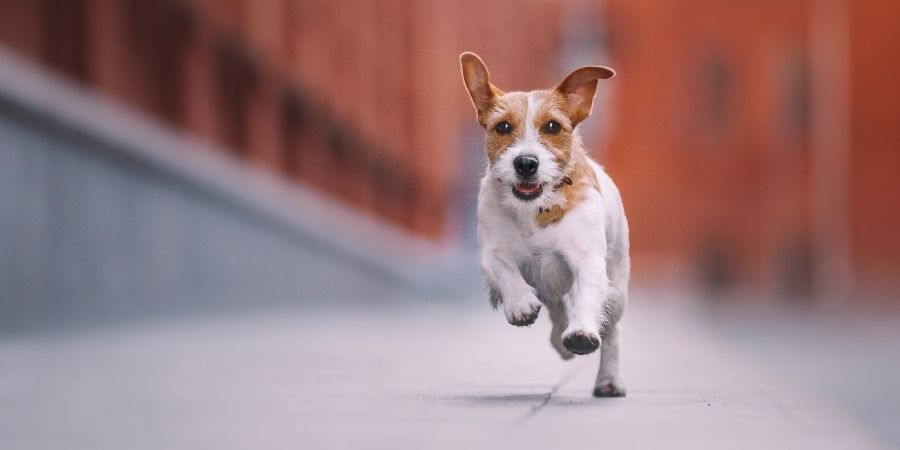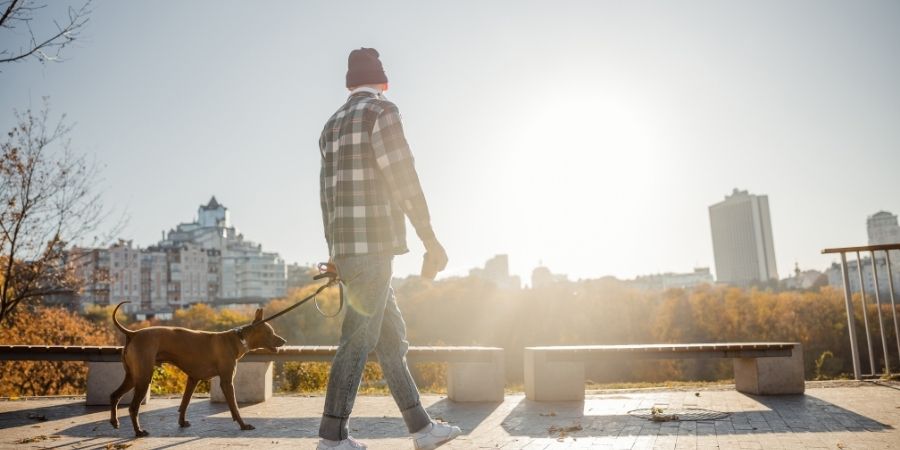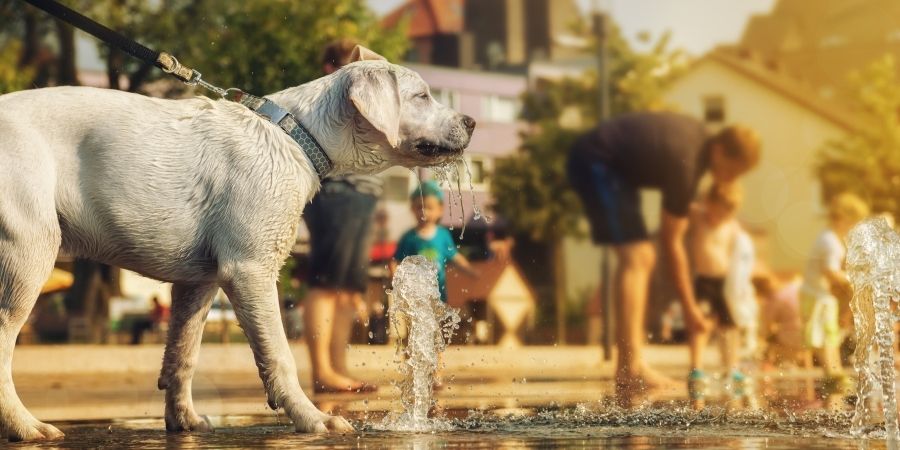Introducing your dog to city life
The city is always on the go and with has lots of smells, sounds, sights and people, which means city living can occasionally be overwhelming for doggies. That doesn’t mean that dogs can’t live in the city, but it does mean that you need to introduce your pup to it gradually.
Slowly getting your dog to used new places such as busy streets, parks or public transport, and praising their calm behaviour with reward based training, is a positive way to help them build confidence. Initially, try to go out at quieter times of day or take a short trip on the bus and build up from there. It might take time, but introducing your dog gradually will set them up for a lifetime of fun in the city!

Apartment living
A life in the city often involves living in a flat, apartment or shared house. Here’s our tips to help make apartment living happy and comfortable for you and your pup!
Check your apartment is dog friendly
First things first, don’t forget to check whether pets are allowed in your apartment before you bring a doggy into your home – you may need to ask for permission first! This is especially important if you’re renting or just temporarily staying in a furnished flat, living in a house share or using a shared garden.
It’s best to check all the information closely and ask questions if you’re unsure, to avoid problems once you arrive. There might be extra rules for your dog, such as areas which your dog can’t use. You may also want to check if there are any other pets in the home or block that your dog might come across.
Make a toileting plan
One of the biggest hurdles when living in an apartment, especially if you don’t have your own outdoor space, is considering where your dog will toilet. Ground or first floor apartments may be more manageable, as it’s not so far to go when taking your dog outside. Higher floors can be more challenging as it can take time to get your dog downstairs and outside.
Think about areas nearby that would be suitable for your dog to toilet such as apartment grounds or a nearby park – and remember to take them regularly. Once you have established a routine, you may find your pup will let you know when they’re ready for their next toilet trip!
If you’re living in an apartment and thinking about getting a doggy, don’t forget that a puppy can need the toilet as often as every 1 – 2 hours. If you’re worried about toilet training, it might be worth considering rehoming an older dog who has already been toilet trained. Just remember that it’s best to try to find an older dog that has already had experience living in the city.
Provide them with their own space
Even if your home is more ‘snug’ than spacious, your doggy will still need their own space. Setting up an area of a room that they can call their own, with their bed and toys, will help your pup to relax. You might want to think about building a den or getting a crate which can be their own little house inside your home.
It’s also important to ensure they have some free floor space for playtime and zoomies!
Daily walks
If you have limited outdoor space for your doggy at home, their daily walks become even more important. Make sure that your dog gets plenty of exercise outside, and encourage them to play games and exercise inside too!
City parks
Gorgeous parks are one of the perks of city life, but with less spots for walkies they can get quite busy – especially with other dogs! Before you head out there’s a few things to consider to ensure a happy, relaxing walk.

Not all parks are dog friendly
Firstly, when heading into a park, look out for signs that tell you whether the park is dog friendly – not all of them are, so always plan ahead!
Consider other doggies
When taking your dog for a walk in a city park, it’s important to remember that you’re likely to bump into lots of other dogs, so you may need to consider whether your dog will enjoy this. If other dogs make your pup feel nervous, you’re best to take them out at quieter times of the day, or consider heading out of the city to a quieter spot where they might have space to themselves.
Having more dogs around also means there could be a higher chance of your dog picking up disease or parasites. Always make sure that your dog’s vaccines are fully up to date, and they are regularly treated for parasites such as fleas, ticks and worms. If you’re not sure if your dog is up to date with their treatments, or when they’re due, speak to your vet for advice.
Avoid scavenging
Everyone loves a picnic in the park but it can sometimes lead to food being dropped on the ground, which can be tempting for your mischievous pup. Not only can some of these foods be toxic to your dog, they may also contain harmful bacteria or even cause a gut blockage.
Keep a close eye on your dog when out and about and ensure they know the command for ‘drop’, so you can step in if they get a hold of anything they shouldn’t have! To avoid scavenging, it’s a good idea to take some of your pup’s own treats on your walk.
Be cautious on warm days
The city can get very hot with limited shade from trees and shrubs, so it’s important to be extra cautious when the weather is warm to prevent your pup getting heatstroke. Seek out shaded spots to stop and rest while out on walkies so your dog doesn’t get too hot. It’s also a good idea to always carry a travel bowl and water while out and about, so you can keep your pup hydrated.
Concrete and tarmac can become incredibly hot in the heat of summer, so always remember to check the ground temperature before walking your dog on a hot day. If you can’t comfortably place your hand on the floor for seven seconds, it’s definitely too hot for your pup’s pads! When it’s warm, it’s best to walk your dog early in the morning or during the evening when the day is cooler.

Be aware of city hazards
Living in the bustling city comes with some hidden hazards for our four-legged friends. It’s important to keep an extra close eye on your mischievous pooch, and always be on the lookout for potential risks. They can include:
- Broken glass: When out and about on walkies, keep an extra close eye out for any broken glass (or other sharp objects!) that may be on the floor and cross the road to avoid getting glass stuck in your doggies paw!
- Dropped food: Litter and soiled foods are a common occurrence on pavements and near rubbish bins. It’s especially important to make sure your dog can’t get at any rotting foods, as they often contain harmful bugs which can make them very poorly.
- Cars and traffic: Traffic can be chaos in the city, so it’s essential that your dog is under close control at all times. Your dog should be on a short lead when walking on the pavement or road. It’s also important that they come back when needed, in case you notice a road coming up while they’re exercising off lead. Busy roads and honking traffic can also be scary for your dog, so it’s important to introduce them to busy areas slowly, using reward based training.
- Think before you leave your dog: When heading out to shops, museums or cafés, remember that it’s not safe to leave your dog tied outside alone or in a hot car. You’ll need to make a plan for them to ensure that they’re safe and happy while you’re having fun.
- Ice and grit in winter: Grit and salt used to thaw out slippery paths or roads can cause problems for pups – it can get caught between their pads and rub and burn the skin, or even lead to stomach upsets if it’s licked off. When taking your doggy for a walk in the icy winter, take extra care to avoid areas with lots of visible grit and always check your dog’s paws for grit, cuts or sores when you get home.
